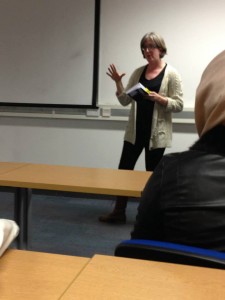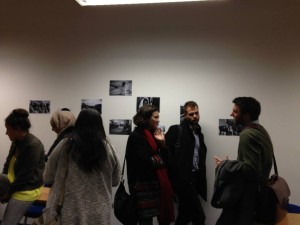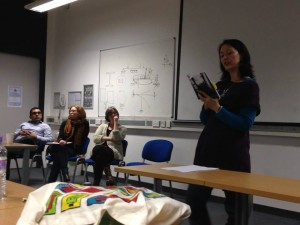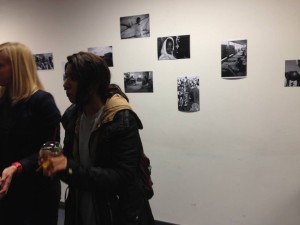With special thanks to Professor and CM contributor, Kati Woronka, CM contributor Mia Ali, and the UEL for hosting us, we held a book event last week. There were great questions and discussion on aid, our essays, and humanitarian work.
Blog
Chasing Misery (a book review)
If you’ve been following my other projects over the past year/months, you know that I’m very much about gaining and presenting, to those who apparently matter to this group of people we call “aid workers.” We’re understudied, usually mis-represented, too-frequently both lauded and also blamed for the wrong things. Beyond a few, frequently cringe-inducing memoirs, the voices of aid workers themselves are largely absent from the majority of current writing, analysis, critique, and other representation of the aid industry.
Depending on which numbers you choose to read and how you choose to read them, females–women–account for anywhere from one-half to two-thirds of the aid industry workforce. This means that if we to understand the global community of people we call aid workers, we inevitably need to look specifically at the experiences of the women who go out to the front lines (including the front lines of Geneva, Brussels, DC, and NYC) to carry out relief and development work.
Chasing Misery: an anthology of essays by women in humanitarian responses is the first book that I’m aware of which shares the experience of aid work from a uniquely female perspective. As the title suggests, it’s a collection of essays and photographs, of and about aid work, by women who are aid workers.
This is not some dry 35,000 ft. theory debate, or boring digression into the weeds of statistical regressions. No, Chasing Misery is an engaging read that keeps you turning pages. The chapters are short and readable, the writing is visceral and emotive. The images are strong, sometimes gritty.
I knew many of the official answers as to why it was broken—
lack of budget allocation at the national and provincial levels,
poor incentives for female doctors to stay in this remote area,
abysmal management, supervision and recognition of health staff,
low education and nutritional status of pregnant women—but
I couldn’t get my heart to understand why, with a multi-million
dollar healthcare project, there wasn’t more care for those babies,
more options for those mothers.p. 107
Chasing Misery is not a book to read if you need a happy ending where all the grateful beneficiaries bow slightly and say ‘thank you’ before returning home, content with their bag of CSB and bottle of vegetable oil. Chasing Misery summarily dispatches the myth that aid is some romantic, soft-focus international adventure. It’s not the end-all-be-all, of course, but then it’s obvious that it’s not intended to be. Chasing Misery is an invaluable early addition to the much too small, but thankfully growing, body of writing and perspective out there by actual aid workers.
It has been years now since I last set foot in the sands of Darfur,
but the condition remains with me still. In books, in friends, in the
far corners of life, I have continued my search for the ‘why’. And I
have yet to find it.
The condition is hard to shake. Surely, there must be some
explanation. So I continue to go around and around in the
maddening cycle of my humanitarian hamster wheel of questioning,
and of all the countless sources.p. 239
If you haven’t already explored UN Women’s book list you might want to do that here. CM is on the list for an upcoming review!
Hyattsville author recounts South Sudan experiences in anthology
An essay by Hyattsville resident Tracy O’Heir has been published in the anthology “Chasing Misery: An Anthology of Essays by Women in Humanitarian Responses.”
“Chasing Misery” is an anthology of essays and photographs contributed by women who worked in humanitarian aid, O’Heir said. The essays are first-person accounts of specific experiences women had which challenged or inspired them.
From 2002 to 2004, during the war between North and South Sudan, O’Heir administered a school system for displaced refugees in South Sudan while working for the Jesuit Refugee Service.
On her way to a friend’s house for Christmas in 2003, O’Heir and a friend were recruited in an effort to find a woman in a difficult labor with twins and bring her to a hospital.
Despite directions from an intoxicated midwife and a flare-up of ethnic conflict, O’Heir said she and her companions managed to get the woman to the hospital, only to find it empty due to the holiday.
Eventually, they were able to get assistance for the woman, but one of the twins died, O’Heir said. The woman and the other newborn survived.
“For me, it highlights the title of the book, ‘Chasing Misery,’” O’Heir said. “Even though this was a bad situation, this was something hopeful I could hold onto.”
The book is available through Amazon or on its website, www.chasingmisery.com.
Top 5 or 10 lists are all the rage, right? Well, this weekend I flew to London where I got to see a copy of CM for the first time. (Didn’t trust that the Pakistani Post would get it to me in a timely fashion!) And as I sat on the couch and held it I just kept thinking…”OMG! This is an actual thing. It exists. It’s a book. It feels like a book. The weight of it is just right. It looks like it’s supposed to look.” It could have been the jetlag but I suppose my surprise and disbelief that an actual copy would be in my hands is related to what I learned from putting it together. So, here are the top five things I learned…
5. Done is better than perfect:
There is this saying that great artists always leave an intentional flaw in their work so they, and their audience, will remember that God alone is perfect. Well, I’d like to say that’s what I did…but no. CM is flawed and imperfect wholly because there were typos I failed to catch. Yes, I picked up the book for the first time and flipped it open to Roberta’s wonderful essay and, SLAP, there it is: TYPO RIGHT IN THE HEADER! (Sorry, Roberta! And we’re fixing it for all future editions as we speak!!) But, at some point in January this year, a thought crossed my mind. ‘Just get it done. It will never be perfect but it needs to be done.’ And that is what we aimed for. So, is the book flawed? Absolutely. Aren’t we all? But it is better than perfect because it is done.
4. Editing is the most quietly heroic profession on earth:
Seriously. Being a writer does not make you an editor. And if you are a writer and you have a good editor, whether professional or not, then you should send them a bunch of flowers or bottle of wine. I mean….RIGHT NOW! Having someone who is willing to read your work and critically examine it for errors, and typos, and flow is amazing. You might not always agree with them but they are worth their weight in gold. Cause, here’s a secret for you…few of us are really good writers. Most of us are mediocre writers who, with someone’s help, and polishing can create something that shines, that’s worth someone else reading. If you’ve found that person. Never. Let. Them. Go.
3. People want to help you:
I don’t know about you but I often find it hard to believe that people are waiting around to be good, to do stuff to help me, to give assistance without expecting anything in return. I find that very hard to believe mostly because I want to do everything. And I want to do it myself (that way I can be assured that it will be PERFECT!) But it rarely is and, with that attitude, so much doesn’t happen because I can’t do everything myself. I need other people. And those other people aren’t going to screw everything up. They might do it differently but they will do it well. And well is better than perfect too.
2. Your story is important to someone else:
One of the hardest parts about editing CM was that I could, and still cannot, read several of the essays without bursting into tears. Miranda Gaanderse’s essay, for example. I cannot read about the wedding napkins in the refugee camp without tearing up. And I have read that essay at least 50 times. That means that it resonates with me and that somewhere in my brain or heart there is a little release and relief that… “Yes! Someone else felt the same way I did. Someone else knows what it’s like.” Graham Greene once wrote, “Sometimes I wonder how all those who do not write, compose, or paint can manage to escape the madness, the melancholia, the panic fear which is inherent in the human situation.” Reading and writing to know that we’re not alone is a powerful reason to do so.
And the number one thing I learned by putting CM together was:
1. Too often fear rules our lives:
I cannot count the number of thoughts I had where I told myself that this was a bad idea; that it was presumptuous to think that I could create something that anyone would be interested in reading. That it would be panned and criticised the moment it was published. That it was unnecessary and silly. That it was a bunch of navel-gazing aid workers. That is was the wrong book…too long, too short, wrong essays, wrong pictures, wrong title. The litany of fearful, self-critical thoughts goes on. And I realised how often we self-edit ourselves and our creativity and our feelings (especially women!) into inaction. How often we don’t do something because we’re afraid that someone, somewhere out there might be critical of it. But, another quote by Jorge Luis Borge that I recently read captures why I feel CM is important because it is our duty – not just our privilege – to be able to create. He says, “The task of art is to transform what is continuously happening to us, to transform all these things into symbols, into music, into something which can last in man’s memory. That is our duty. If we don’t fulfil it, we feel unhappy.”







![Pageflex Persona [document: PRS0000026_00020]](http://aidspeak.files.wordpress.com/2014/03/chasing-misery-cover.jpg?w=191&h=300)

